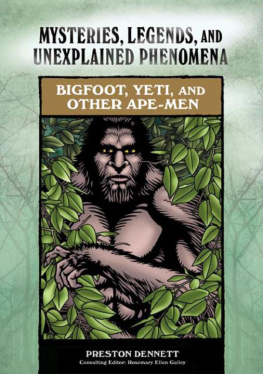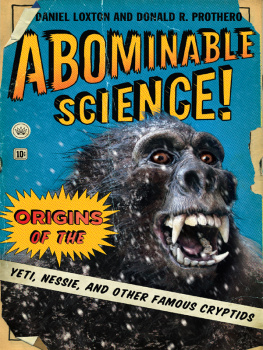ABOMINABLE SCIENCE!

COLUMBIA UNIVERSITY PRESS
Publishers Since 1893
New York Chichester, West Sussex
cup.columbia.edu
Copyright 2013 Daniel Loxton and Donald R. Prothero
All rights reserved
E-ISBN: 978-0-231-52681-4
Library of Congress Cataloging-in-Publication Data
Loxton, Daniel, 1975
Abominable science! : origins of the Yeti, Nessie, and other famous cryptids/Daniel Loxton and Donald R. Prothero.
pages cm
Includes bibliographical references and index.
ISBN 978-0-231-15320-1 (cloth : alk. paper)
ISBN 978-0-231-52681-4 (e-book)
1. Cryptozoology. 2. Animals, Mythical. 3. Pseudoscience. I. Prothero, Donald R. II. Title.
QL88.3.L69 2013
001.944dc23
2013008424
A Columbia University Press E-book.
CUP would be pleased to hear about your reading experience with this e-book at .
COVER DESIGN: PHILIP PASCUZZO (PEPCOSTUDIO.COM)
COVER IMAGE: DANIEL LOXTON
BOOK DESIGN: VIN DANG
The foreword appeared in a modified form in Scientific American, and other material appeared in a modified form in Skeptic magazine and on Skepticblog.org.
References to Internet Web sites (URLs) were accurate at the time of writing. Neither the authors nor Columbia University Press is responsible for URLs that may have expired or changed since the manuscript was prepared.
THIS BOOK IS DEDICATED TO
Ronald Binns, David Daegling, Benjamin Radford, Joe Nickell, Blake Smith, Karen Stollznow, Darren Naish, Sharon Hill, Matt Crowley, and all the brave skeptics who have blazed the trail of scientific inquiry in cryptozoology despite the tremendous cultural pressures to follow the crowd and give in to easy answers
CONTENTS
 | CRYPTOZOOLOGY
REAL SCIENCE OR PSEUDOSCIENCE? |
 | BIGFOOT
THE SASQUATCH |
 | THE YETI
THE ABOMINABLE SNOWMAN |
 | NESSIE
THE LOCH NESS MONSTER |
 | THE EVOLUTION OF THE SEA SERPENT
FROM HIPPOCAMP TO CADBOROSAURUS |
 | MOKELE MBEMBE
THE CONGO DINOSAUR |
 | WHY DO PEOPLE BELIEVE IN MONSTERS?
THE COMPLEXITY OF CRYPTOZOOLOGY |
SHOW ME THE BODY
IN JANUARY 2003, the world lost the creators of two of its most celebrated bio-hoaxes in modern times: Douglas Herrick, father of the risibly ridiculous jackalope (half jack rabbit, half antelope), and Raymond L. Wallace, godfather of the less absurd and more widely believed Bigfoot. The jackalope enjoins laughter in response to such peripheral hokum as hunting licenses sold only to those whose IQs range between 50 and 72, bottles of the rare but rich jackalope milk, and additional evolutionary hybrids like the jackapanda. Bigfoot, though, while occasionally eliciting an acerbic snicker, enjoys greater plausibility for a simple evolutionary reason: large, hirsute apes presently roam the forests of Africa, and at least one species of a giant apeGigantopithecusflourished several hundred thousand years ago alongside our early human ancestors. Footprints in the mud really did mean that another bipedal primate was lurking about.
Is it possible that a real Bigfoot lives despite the confession by Wallaces family, after his death, that the tracks found by one of his employees were just a practical joke by a fun-loving prankstera guy in an ape suit? Certainly. After all, although proponents of Bigfoot do not dispute the evidence that Wallace tromped around in strap-on Shaq-o-size wooden feet, they correctly note that tales of the giant Yeti living in the Himalayas and Native American lore about Sasquatch wandering around the Pacific Northwest emerged long before Wallace pulled his prank in 1958.
Throughout much of the twentieth century, it was entirely reasonable to speculate about and search for Bigfoot, as it was to look for the monsters of Loch Ness and other lakes and to investigate the visits to Earth by extraterrestrials. Science traffics in the soluble, so while jackalopes do not warrant our limited exploratory resources, for a time these other creatures did.
The study of animals whose existence has yet to be proved is known as cryptozoology, a term coined in the late 1950s by the Belgian zoologist Bernard Heuvelmans. Cryptids, or hidden animals, begin life as muddy footprints, blurry photographs, grainy videos, and anecdotes about strange things that go bump in the night. Cryptids come in many forms, including the aforementioned giant pongid and lake monsters, as well as sea serpents, giant octopi, snakes, birds, and even living dinosaurs (the most famous being Mokele Mbembe, purportedly slogging through the rivers and lakes of the Congo Basin in Central and West Africa).
The reason that cryptids merit our attention is that there have been enough discoveries of previously unknown animals by scientists based on local anecdotes and folklore that we cannot dismiss all claims a priori. The most famous examples include the gorilla in 1847 (and the mountain gorilla in 1902), the giant panda in 1869, the okapi (a short-necked relative of the giraffe) in 1901, the Komodo dragon in 1912, the bonobo (or pygmy chimpanzee) in 1929, the megamouth shark in 1976, the giant gecko in 1984, the beaked whale in 1991, and the spindlehorn ox from Vietnam in 1992. Cryptozoologists are especially proud of the catch in 1938 of a coelacanth, an archaic-looking fish believed by zoologists to have gone extinct in the Cretaceous period, as if to say See, Bigfoot really is out there, and we just have to keep looking.
Although discoveries of new species of bugs and bacteria are routinely published in the annals of biology, the gorilla, beaked whale, and other examples are startling because of their recentness, size, and commonality to the famous Bigfoot, Nessie, Mokele Mbembe, and other cryptids. But all of them have one thing in commona body! In order to name a new species, taxonomists must have a type specimena holotypefrom which a detailed description can be made, photographs taken, models cast, and a professional scientific analysis published.
Anecdotes are a good place to begin an investigation, but anecdotes by themselves do not constitute a new species. In fact, in the words of the social scientist Frank J. Sullowaywords that should be elevated to a maxim: Anecdotes do not make a science. Ten anecdotes are no better than one, and a hundred anecdotes are no better than ten.




















